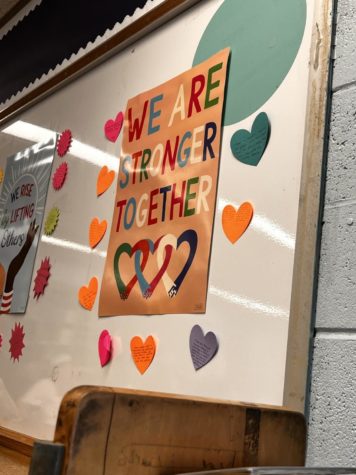SEL Creates a Safe Space for Mental Health Awareness
 It’s getting bad again. You’re in the dark, thoughts swirling, music blasting, and trying to figure out how to get yourself out of this situation. If you’ve ever felt like this, just know that you’re not alone. 50% of individuals go through some form of mental health disorder in their lifetime. However, only 16.5% of those people actually seek help.
It’s getting bad again. You’re in the dark, thoughts swirling, music blasting, and trying to figure out how to get yourself out of this situation. If you’ve ever felt like this, just know that you’re not alone. 50% of individuals go through some form of mental health disorder in their lifetime. However, only 16.5% of those people actually seek help.
Social-emotional learning (SEL) can help students learn how to calm their mind and learn skills that can help them outside of the classroom.
“I think SEL is extremely important, especially after the last few years where a lot of people were isolated and didn’t have as many social interactions.” English teacher Ms. O’Connell said. “Some people, because of the isolation, didn’t really have the help they needed to process a lot of the emotions they were feeling and I think, in terms of learning, students do best when they feel emotionally connected and emotionally at peace.”
As Ms. Whitney put it, Social-emotional learning is helping and recognizing students as a whole, and not just the academic side of them. SEL plays a big part in spreading mental health awareness.
“It’s realizing the student as a whole person and not just focusing on them academically, but also keeping in mind their social and emotional wellness,” English teacher Ms. Whitney said. “It’s making sure that, with that in place, they can learn better and succeed more.”
The SEL method was formed in 1994 when scholars from multiple fields – such as emotional intelligence, child development, prevention science, bullying prevention, and public health- came together to identify key skills and competencies students need to successfully navigate school and life.
“We do it every week, once a week, every Monday because we’re just getting back from the weekend and she (Ms.Whitney) wants us to prepare for the week that’s coming up,” junior Jennifer Zhu said. “After these exercises, I feel like I want to go to sleep because they’re relaxing.”

Social-emotional learning plays a big part in helping students learn how to process their emotions.
“We meditate sometimes and I sit there and meditate with the kids,” Ms. O’ Connell said. “Sometimes we just do quick mental health or emotional checks and I always add an answer for that as well because I think it’s important for students to know that adults feel these things too.”
Mental health awareness is extremely important because it plays a big role in our lives. It affects how we feel, how we act, how we interact with others, and what we are able to complete in a day.
“I think it has a very big impact, because depending on my mental health, it impacts how I treat people and how I react to certain things,” sophomore Henrich Mauricio said. “If I’m happy, and my mental health is good, then I’ll be very easy to talk to. But, for instance, if I were not in such a good mood, I’d be a lot harder to talk to and more on the edge of things.”
Mental health awareness can also help with people that struggle with hidden mental disorders. Depression rates amongst the youth have risen from 12.9% to 25.2% from pre-pandemic to 2021. Spreading awareness can make the difference between someone learning how to care for their mind, and someone deciding to cut their life short.

“I feel like mental health awareness is really important these days, especially with the rising number of suicide rates, because teenagers are facing a lot more stress compared to the past century with recent standardized testing and other pressures from parents,” Jennifer Zhu said.
However, it’s not just teachers that are helping to advocate for mental health awareness. Students, like Xinjie Zheng, the Mindfulness & Meditation Club president for example, have also taken a stand to spread mental health awareness and teach students how to care for their mind.
“Mental health is very important because it can influence people’s moods,” Zheng said. “Every time I struggle, I go to a meditation club and the teacher and other students will help me focus more on positive thinking.”
Although mental health is advocated for in some places, there are still many stigmas that exist around it. These stigmas develop from media influence, and lack of understanding, which can stop many children from reaching out to others about their mental health.
“What bothers me the most is the use of the word “crazy” or when people say they’re bipolar just because their moods change,” Ms. Whitney said. “I think it shows a lack of awareness and empathy towards the actual people who have those conditions.”
“Since it’s not physical health, people think that they’re more in control of its,” Ms. Whitney added. “If someone has a disease like diabetes, people say ‘okay they need medication and here are the steps.’ But if someone has panic attacks, it’s not looked at the same, and people think that they are just not strong enough to overcome it.”
One of the best ways to eliminate the stigma is by just talking about it more often and normalizing it. As Ms. O’ Connell said, we could also make resources more available and known.
“We have to have more conversations about it and talk about different strategies that people can use to help themselves,” Ms. O’ Connell said. “We could make resources more well known to people who may need a little extra help. The more we talk about it and normalize it, the less stigmas are attached to it.”
But there shouldn’t be any stigmas attached to mental health in the first place. Struggling with your health is extremely common, given that one in seven children and teens have at least one treatable mental health disorder.
“Many people don’t reach out because they are scared to talk about things that are painful,” Psychologist Dr. Sanford A. Schwartz said. “There really shouldn’t be any stigma, problems with your mental health are just like any other problem, you go to a doctor, and they help you fix them.”







